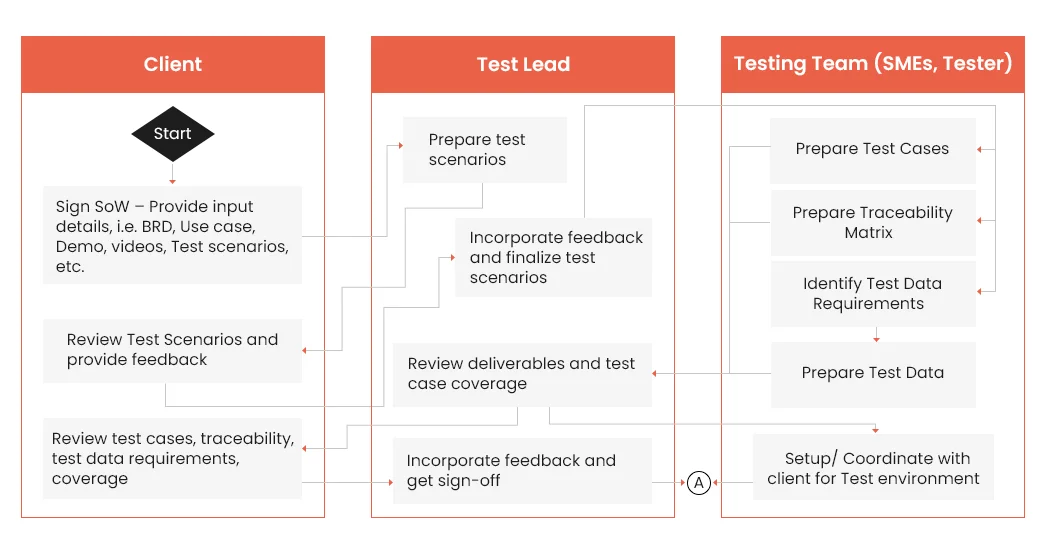
Manual testing services are crucial because they bring a personal touch to the quality assurance process, capturing subtleties that automated tools might miss. This human element is vital for evaluating user-friendliness, understanding real-world usability, and ensuring that the software feels intuitive to users.
At Tx, we have a team of experts who harness their critical thinking and creativity to explore every corner of an application. We focus on detailed, scenario-based testing that mimics actual user behaviors and environments, ensuring that your software performs flawlessly under all conditions.
Manual Software Testing Challenges and Solutions

- Significantly slower than automated testing, especially for large-scale or complex applications
- Time consuming because efforts have to be repeated each time
- Extensive documentation required to ensure that tests are repeatable
- Can be more costly in terms of both time and labor
- We follow an approach that optimizes test procedures to minimize repetition and ensure efficiency.
- Specialized tools to document tests efficiently, ensuring repeatability without the overhead of cumbersome documentation processes.
- Prioritizing critical test areas and employing risk-based testing strategies
- Continuously training of our testers on the latest manual testing techniques and tools
Business Benefits Delivered
Get In Touch- Dedicated TCOE for all testing solutions
- Improved stability of overall application and resulting components activities in
- business flow
- Significantly increased the efficiency, effectiveness and the quality of the products
Our Clients
Our Manual Testing – Value Proposition
Our manual functional testing Service will provide our customers with the ability to:
Manage Requirements
Both functional and non-functional by defining and prioritizing critical vs. non-critical requirements.
Manage Change
Manage the changes to requirements with detailed impact analysis, including effort estimation.
Manage all defects
Manage all defects with associated workflows ensuring segregation of duties in terms of test definition, execution and defect correction.
Repeatable Test Plans
Development of repeatable test plans in order to repeat or automate at a later stage.
Domain Specialists
Our test engineers are domain specialists who come with a good understanding of client application both from functional and non-functional aspects.
Speak to an expert
In your line of work, we know every minute matters.
Tx Manual Testing Workflow
At Tx, we follow a transactional manual testing workflow which typically involves planning test cases, executing them to validate each function, and documenting outcomes to ensure all business transactions are performed accurately and meet specified requirements.

Recent Insights
Why Choose Tx?
Frequently Asked Questions (FAQs)
In manual testing, testers execute test cases without using automation tools to identify bugs, usability issues, and functionality gaps. It ensures software quality by validating UX, business logic, and system behavior.
Manual testing brings nuanced human insight—especially for usability and real-world user behavior—that automation can miss, ensuring your software feels intuitive, reliable, and user-centric.
We minimize repetitive effort using streamlined testing procedures, risk-based prioritization, and efficient test documentation to deliver maximum coverage with reduced effort.
Our domain-specialist testers handle both functional and non-functional aspects, crafting repeatable test plans from requirement understanding to test execution and documentation.
Our testing aligns with Canadian standards, including privacy laws (PIPEDA) and accessibility guidelines (WCAG), ensuring compliant and user-friendly software.
We leverage risk-based testing, smart test case design, and domain-focused teams to reduce effort, improve coverage, and optimize QA costs.
We at Tx embed manual testing within Agile sprints and CI/CD pipelines to ensure continuous feedback, faster defect detection, and improved release quality.
Tx offers comprehensive manual testing services, including functional, exploratory, regression, usability, compatibility, and acceptance testing. We ensure software reliability, user-friendliness, and seamless functionality across platforms.
Manual testing can be time-consuming, prone to human errors, and difficult to scale for large applications. It requires skilled testers to execute repetitive tasks efficiently while ensuring thorough coverage. Balancing manual and automated testing can help overcome these challenges.






